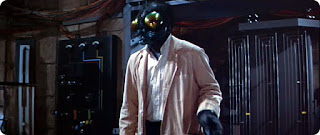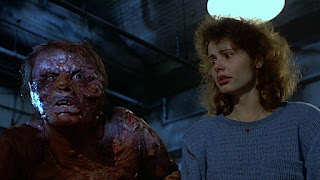Welcome to the third installment of my 'Remakes Done Right' series where I look at some of the better remakes in the world of horror cinema. First I looked at Werner Herzog's chilling re-vamp (pun intended) of Nosferatu, then two weeks ago I delved into Fede Alvarez' gore filled Evil Dead remake/reboot, what have you. I didn't get a chance to do a post last week, but this week I will continue the series by looking at what is quite possibly the greatest remake of all time. A film about grizzly transformations, dangerous experiments, and deep down, love, David Cronenberg's The Fly. Based on the classic 50's sci-fi film of the same name, which in turn was based on a short story by French writer George Langelaan, Cronenberg's The Fly differs greatly from its source material and only maintains the same basic premise. However, despite diverging so drastically from the original, Cronenberg's film ultimately surpasses it and creates a much more thought-provoking, emotionally gripping, and vomit-inducing film, keeping in tone with the many other darker sci-fi films of the 80's.
The Original
Based on George Langelaan's short story of the same name, the original The Fly follows a grieving widow names Helen (Patricia Owens) who recounts the bizarre tale of her husbands death. Her husband Andre (David Hedison) had invented a transportation machine that he proceeded to test on himself, however, after a fly made its way into the machine, Andre emerges as a grotesque human/fly hybrid. The Fly is an essential 50's science fiction film, incorporating ideas of teleportation and transformation, it's a classic tale of a well-meaning experiment gone wrong. Andre is not a bad guy, he is an ambitious scientist who dreams of inventing a machine that could teleport people from one place to another. Ultimately his ambition gets the better of him and he winds up having the head and claw of a fly. Truly the highlight of this film is Hedison's performance as the fly monster itself, relying more on movement than dialogue, he provides some pathos to the conflicted creature while giving himself this very insect-like presence with his twitching movements. Patricia Owens also gives a powerful performance as Helen while Vincent Price, despite his minor role, is memorable as Andre's brother Francois. Of course, the real punch line comes at the end in a twist that I will not spoil, but needless to say poor Andre doesn't get a happy ending.
The Remake
In the early 80's, producer Stuart Cornfield and screenwriter Charles Edward Pogue began to work on a remake of The Fly, altering the original story to focus on the more gradual transformation of the lead character. After a number of rewrites and original director Robert Bierman dropping out due to a family tragedy, David Cronenberg came aboard as director along with rewriting the script while retaining elements from Pogue's original one. Cronenberg had already become an established filmmaker at the time, known for his outlandish horror films such as Shivers and Videodrome, however The Fly would arguably become his greatest film yet. Jeff Goldblum was cast in the lead role of Seth Brundle, the ill-fated scientist, while Geena Davis starred as journalist, Veronica. After its release in 1986, the film gained critical acclaim for its performances, its special effects, and its underlying themes of illness and death. Most notable of all, the film gave us the iconic quote, 'be afraid, be very afraid'.
What it Does Right
Like many of David Cronenberg's horror films, The Fly contains some outstanding special effects. Throughout the film we see the gradual transformation of Seth Brundle from man to fly thingy, and the final result is a sight to behold. Chris Walas, the man who brought the Gremlins to life, managed to create this gradually grotesque transformation, beginning with subtle mutations before culminating in a bizarre creature christened 'Brundlefly'. It's safe to say this version of The Fly is a lot more disgusting than its predecessor, not that it's a bad thing, in fact it's one of the films greatest assets, it's just not for the faint-hearted. Fingernails fall off, skin deteriorates, and there is vomit galore in this film, Brundle's transformation is certainly not a swift one. Cronenberg has stated that this gradual transformation throughout the film is a metaphor for illness or ageing, something gradual that we all experience. As the film tends to follow Veronica for the most part, we are forced to watch with her as her lover gradually deteriorates into the disgusting Brundlefly. This gives the film a powerful sense of emotional depth despite the gruesome imagery, it's an interesting juxtaposition that works extremely well here. As well as Brundlefly, Walas thought up some other memorable monstrosities including the maggot baby from Veronica's dream and the fabled babbon-cat that was reduced to a deleted scene.
I've mentioned the films strong emotional heart, the foundations of which lie within Cronenberg and Pogue's script, however this sense of emotion is truly brought to life by Goldblum and Davis' performances. Goldblum gives more than just a phenomenal performance, he gives a number of phenomenal performances, each one for a different stage of his transformation. Beginning as an ambitious scientist, gradually becoming more cocky during the middle phase of his transformation, before becoming utterly insane by the latter stage. Goldblum is sensational to watch from start to finish, but it would be cruel to overlook the performance of Geena Davis who takes on the role of Veronica, a budding journalist who covers Brundle's experiment. While Brundle undergoes a drastic physical transformation throughout, Veronica goes through her own internal transformation and must step up to the plate and attempt to save Seth from himself. It is a powerful, very human performance that matches Goldblum's in a much more subtle way. To top it all off, hearing her utter those historic lines is incredibly chilling still to this day. Davis and Goldblum were the perfect choices for the leading roles in The Fly and stand out as some of the greatest casting choices in horror cinema.
Usually when a remake diverges so drastically from the original it doesn't go too well, look at Halloween II for example I mean what the ass was that? It was a bold choice for Pogue and Cronenberg to weave a very different tale from the same premise, but it turned out to be a gamble worth taking. During the time between the original The Fly and the remake, science fiction had changed immensely, it was a much darker genre that had the advancements of modern technology on its side. In order for the film to appeal to contemporary audiences and keep in tone with the increasingly popular sci-fi genre, the story had to undergo a drastic transformation. Pogue and Cronenberg's new screenplay allowed this to happen and accommodated the latter's distinctive directorial style. The cheesy sci-fi tale of the 50's had become a thought-provoking body horror similar to the previous films of Cronenberg, presenting a brand new tale while retaining the same premise of the original. It kept enough elements from the original to make it The Fly, but changed enough to make it something more fresh and original. While this is a remake at heart, this is very much a Cronenberg film, and a damn fine one at that.
The Fly takes a number of risks that don't often work with remakes, it has a completely different plot, different characters, and has a wildly different tone. However, these differences are some of the films strongest assets and are what allow it to surpass the original. It is a more updated tale for contemporary audiences with a strong emotional core and special effects that are as intricate as they are disgusting. The original The Fly is one of the few films that I'll admit was begging to be remade, and with the many advances in technology and special effects by the 80's there was no better time to do so. Surpassing the original and furthering the growing career of David Cronenberg, The Fly is without a doubt a remake done right.
















